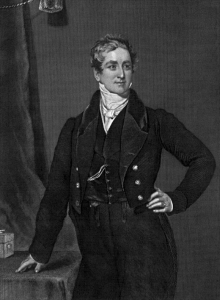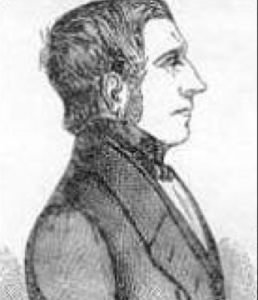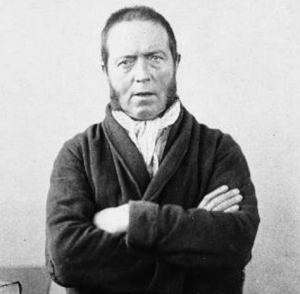Daniel McNaghten
Daniel McNaghtenA was a Scotsman who became famous when he killed the private secretary to the Prime Minister, Sir Robert Peel, in January 1843 whilst suffering from paranoid delusions which were typical of paranoid schizophrenia. His case is notable because it resulted in the creation of a new set of legal principles concerning the defence of insanity which were to be used widely in the English court system for over a hundred years and which was also to inform legal practice in many other Commonwealth countries and no less than 15 states of the US.
Daniel McNaghten was born in 1813 in Glasgow, Scotland. He was a woodturner by trade but had followed a number of abortive callings including studying acting and medicine. He was also an enthusiastic political activist and worked in the Chartist and trade union movement in his home town.
Although he was very successful in his chosen career, by the time McNaghten reached his mid twenties the first signs of mental turmoil had begun to set in. According to Asokan, McNaghten had developed complex and ornate delusional beliefs centred around a conspiracy by Catholics, Jesuits and Tories4. It should be remembered that England was a staunchly protestant country led by a protestant monarch with a history of religious division and that stories of plots by Catholics to overthrow the monarch and install a Catholic in her place were commonplace. Glasgow in particular was rife with religious division.
In schizophrenia delusions of a religious nature are very common even today. In fact they are so common that psychiatrists have a name for it: “religiosity”. Schizophrenic delusions also have a habit of taking as their framework the contemporary issues of the day and since in the early nineteenth century religious plots were widely held to exist it is no surprise that McNaghten’s delusional complex took on this form.
Over the space of two to three years McNaghten’s delusional beliefs gained first a toehold and then a full grip on his psyche and his beliefs and behaviour became increasingly disturbed. He described the conspiracy that he believed he was the victim of to his friends and family and begged them to help him. He pleaded with his father: “I am persecuted by those who have entered into a conspiracy against my welfare and life. I ask for your protection. You are known to the authorities. I entreat you to get them to protect me”.8
Then on 20th January 1843 McNaghten caught sight of Edward Drummond, the secretary to the Prime Minister, Sir Robert Peel outside the PMs home in Whitehall Gardens in central London. Erroneously believing him to be Peel himselfB, McNaghten followed him and then shot him in the back with a pistol, seriously wounding him. He was immediately apprehended by a passing policeman assisted by some bystanders following a violent struggle and then taken to Gardener’s Lane Police Station.

Sir Robert Peel, English Prime Minister who McNaghten tried to kill. (Image: Wikimedia Commons)
Drummond survived the shooting for five days but was to finally succumb to his wounds on Wednesday 18th January at his home in Mayfair. He was 50 years old at the time of his death and had spent most of his adult life in the civil service being very highly regarded for both his skill and personality. Drummond’s inquest was held on Thursday 19th January and according to contemporary press reports the jury returned a finding of “Wilful Murder”.
Following his arrest, McNaghten was held in Tothill Fields Prison in London where he was observed to be reading the bible enthusiastically. However his interrogation at Bow Street Police Station, according to Asokan, gives a very revealing insight into the nature and depth of his delusional beliefs: “The Tories in my native city have compelled me to do this. They followed me to France, into Scotland and all over to England. In fact, they follow me wherever I go… They have accused me of crimes of which I am not guilty; they do everything in their power to harass and persecute me. In fact they wish to murder me.”4 He also claimed to have heard his spies questioning him audibly which may well indicate that he was also hearing voices (or what doctors today call auditory hallucinations).
It seemed to poor Daniel that everywhere he went the spies followed him. He moved to London and even to France to try to get away from them but they followed him even there. How familiar this will be to anyone who has had the misfortune to have endured this kind of paranoid schizophrenia.
McNaghten was arraigned for trial at the Central Criminal Court in London known as the Old Bailey and his trial was postponed until March to enable medical reports to be prepared and to allow witnesses to travel down from Scotland and over from France. His trial finally went ahead on the 3rd March with the bench headed up by no less than the Lord Chief Justice himself and lasted just two days. The defence, presented by his counsel, Alexander Cockburn, rested on his state of mind at the time of the killing: he did not deny doing the act. According to his counsel, McNaghten was the “victim of a fierce and fearful delusion” and to support this claim no less than nine medical experts testified as to his insanity.

Portrait of Daniel McNaghten at his trial.
(Image: Wikimedia Commons)
In an eloquent description of his earlier life Cockburn described McNaghten as having a personality predisposed to insanity what today some would describe as a schizoid personality. Evidence was also adduced as to the integrity of McNaghten before his illness: that he was very law-abiding, sober, prudent and industrious by nature and was very kind towards children and animals. Cockburn relied heavily for guidance on the work of the US psychiatrist Isaac Ray in his work “A Treatise on the Medical Jurisprudence of Insanity”.6
Friends and family also testified that McNaghten’s paranoid beliefs had pre-dated the offence by several years and that two years beforehand he had accused members of the Glasgow Council of being part of the conspiracy to persecute him. They also testified that he would often be up all night and would be seen talking to himself in muttered and incoherent speech. He would burst out laughing spontaneously at no particular cause and would appear unmoved when given sudden bad news.
A total of nine doctors gave evidence to the court for both the crown and the defence and time after time they testified that they had examined McNaghten and that they were convinced that he was insane. Dr Monro from the Bethlem Hospital said this, “…. the person at whom he fired gave him a scowling look. At that moment all the feelings of months and years rushed into his mind and he thought that he could only obtain peace by shooting him”.8
McNaghten was found “not guilty by reason of insanity” and thus avoided the death sentence but was instead sentenced to be confined in the Bethlem Hospital in South London “to await the Crown’s Pleasure”. This was what we would today call an indeterminate sentence. And McNaghten was indeed to spend the remainder of his days behind bars. He spent the next 21 years confined in the Bethlem until 1864 when the new state-of-the art facility for criminal lunatics at Broadmoor Hospital in Berkshire opened and to where he was sent.
Not much is known about the course of McNaghten’s illness or his life in general following his confinement. Clinical note keeping at both hospitals was poor. However he is described as having become extremely withdrawn and unsocial although his paranoia continued. This sort of social withdrawal and flatness of emotions is also typical of the negative symptoms of schizophrenia. He is not recorded as being violent either towards staff or to other patients but at one stage he did start to refuse food and had to be force fed.

Portrait of Daniel McNaghten in his later years. (Image: Henry Hering from Wikimedia Commons)
By the age of 50 McNaghten’s physical health had started to fail. He had begun to complain of heart problems. He died on 3rd May 1865 at Broadmoor at the age of 52 and is buried within the grounds of the hospital. As in so many cases of schizophrenia today it was not his mental terror that finally killed McNaghten but the increased risk of physical health conditions that goes along with this complex mental condition. The official cause of death at his post mortem examination was given as “anaemia, brain disease and gradual failure of the heart’s action”.5
The verdict in McNaghten’s case caused some public controversy with many feeling that, given the blatant nature of the attack, he got off with an overly lenient sentence. Even Queen Victoria, who had herself earlier been the victim of an armed attack by a person with mental illness, intervened in the debate. As a consequence the House of Lords, which was then the highest court in the land, was asked to discuss the matter of the insanity defence and the result was a set of legal guidelines which were to become known as the McNaghten Rules.
However the public’s condemnation of McNaghten was not unanimous and in this case as in the later case of the Victorian artist Richard Dadd we see a certain degree of understanding in some of the contemporary press reporting of the case that we rarely see in reporting of mental health cases today. Take for instance this excerpt from the Preston Chonicle: “The fault in this case was that he was not properly cared for before the commission of the fatal deed”2.
The McNaghten rules established two tests that were to be satisfied if a defence of insanity were to be successful in an English court. The first was that the accused “must be suffering from a defect of reason from a disease of the mind”. The second test is that “the disease of the mind must be such that the accused person did not know the nature and quality of his act or if he did have such knowledge he did not know that the act was wrong”.3
The insanity defence does endure but today is only heard in the English court system in a handful of cases each year with defence teams preferring the diminished responsibility defence in cases of killing. Whether this is of benefit to the defendant in the long run is, in our opinion, highly debatable. The diminished responsibility defence may well result in a shorter period of confinement for the accused but it ensures that the detention is served out in the punitive prison system rather than in the therapeutic setting of hospital where they belong. Given the parlous state of mental health facilities within the present day English prison system it virtually ensures that the accused receives very little by way of psychiatric care for their condition and in addition leaves them vulnerable to the predatory attentions of the murderers and rapists with whom they have to share their accommodation. This was a lesson that the Victorians learnt but that we seem to have forgotten. However the British legal profession have in recent years developed a general aversion to the mental health defence in many types of cases and we discuss this issue in more detail in our information sheet on the Insanity Defence.
Amongst the doctors who interviewed McNaghten at the time of his trial was Dr Edward Monro from the Bethlem Hospital who had some 30 years experience of treating mental illness. His initial diagnosis was of monomania: a term that has long fallen into disuse. Another doctor who saw him, Dr Hutcheson from the Royal Asylum, also said that “the delusion was so strong that nothing but a physical impediment could have prevented him from committing the act”5. By the time McNaghten was transferred to Broadmoor the diagnosis was changed to “chronic mania and dementia”. These diagnoses, although appropriate to the level of understanding of insanity at the time, have no use in modern medicine and McNaghten has been retrospectively diagnosed with paranoid schizophrenia a condition for which the diagnostic criteria did not exist until many years after the killing of Drummond.
The illness of schizophrenia was not described by Kraepelin until 1899 and the term schizophrenia did not come into use until it was first applied by Eugen Bleuler in 1908. Had the case come up today it is fairly certain that McNaghten would have been diagnosed with paranoid schizophrenia: everything points to that: the age of onset at around 24, the complex and ornate structure of paranoid delusions, the auditory hallucinations, the reversed body clock, incongruous emotional responses and the incoherent speech followed by the later appearance of the negative symptoms whilst confined in hospital are all very suggestive of the schizophrenic condition and put together make a diagnosis fairly clear cut.
Latterly some scholars have speculated that McNaghten’s defence of insanity was in fact fraudulent and that he simply feigned insanity to avoid the hangman. They also claim that the real motive for the killing was McNaghten’s political activism and that Drummond was actually the victim of a botched political assassination rather than the deranged act of a mad man. The evidence for this claim however is rather thin. At the time of the trial the court had the benefit of the testimony of a large number of very learned medical professionals and also the testimony of friends and co-workers of McNaghten who all testified to the delusions that he had long been expressing to them. It is notable that all of the doctors called to give evidence by both the prosecution and the defence agreed on McNaghten ‘s insanity.
Some scholars, notably the US sociologist Richard Moran, have even claimed that McNaghten really was being persecuted by the Tories and Jesuits and that his trial was a massive conspiracy aimed at covering this up. It is odd how schizophrenia attracts these kinds of potty notions.
Although the defence of insanity in criminal cases had been available to the defence before McNaghten his legacy undoubtedly was the McNaghten Rules which were to remain the sole test of criminal responsibility in the case of mental illness until largely replaced by the diminished responsibility defence in the 1950’s. As Rollins points out: had McNaghten’s victim been someone of no social standing or political importance the impact of his act would have been very different.5 Although McNaghten was to end his life in obscurity he can be credited with having brought about highly significant and far reaching changes in the criminal law which were to remain for over a hundred years. It is truly tragic that the price of that real progress was the premature, sad and traumatic death of an able and valued member of our government.
Footnotes:
A. There is some controversy over the spelling of McNaghten’s name. Although his signature on official documents survives it is illegible and consequently the spelling differs amongst scholars even to this day.
B. Scholars differ as to this explanation of the motive. It is true that McNaghten stated at one interview with the police that he believed that the person he shot was Peel but at other times he said that Drummond was a member of the “crew” of people spying on him and that he knew this because he had scowled at him when they passed in the street.7
References
1. Cheltenham Looker On, 21/01/1843.
2. Preston Chronicle, 11th March 1843.
3. Andoh B, The McNaghten Rules, The Story so Far, published in the Medico-Legal Journal 1993.
4. Asokan TV, Daniel Mc Naughton (1813 – 1865), published in the Indian Journal of Psychiatry, July-Sept. 2007.
5. Rollin H, Crime and Mental Disorder a Case in Point, published in the Medico Legal Journal 1982.
6. Bennet M, Criminal Law as it Pertains to Mentally Incompetent Defendants published in the Australian and New Zealand Journal of Psychiatry, January 2009.
7. Dalby JT, The Case of Daniel McNaughton: Let’s Get the Story Straight, published in the American Journal of Forensic Psychiatry, 2006.
8. Bousfield R and Merret-Primary R, The Report of the Trial of Daniel McNaughton for the Murder of Edward Drummond, In the public domain.
Author: David Bell.
Copyright © January 2018, LWS (UK) CIC.







